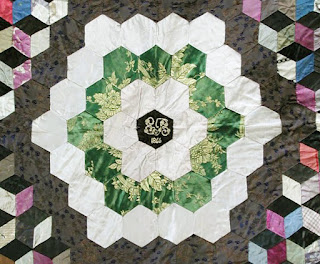Silk mosaic quilt inscribed with initials
EB and 1866 in the center hexagon
On my Material Culture blog I answered a question about accurate hand-sewing project for Mel and Annette, Civil War re-enactors. In that post I suggested hexagon mosaics of cotton prints, similar to Mary Anne Healy's 1861 quilt at the Smithsonian Institution.
Detail of a cotton quilt date-inscribed 1861,
Mary Anne Jefferson Healy 1847-1928.
Collection of the Smithsonian
Mary Anne might have begun this as a 14-year-old in 1861.
The other question that Mel and Annette had concerned period-accurate papers to baste the cotton hexagons over.
"For the paper piecing, would it be appropriate to cut (reproduction) Harper's Weeklies or some other such type publication?"
That seems reasonable, although I wouldn't want to use flimsy newsprint, which might be hard to baste over and prone to yellow. If the reproduction paper looked substantial enough that's a good idea.
Other options:
I looked at my files of hexagon backs and came up with some ideas and examples.
Other options:
I looked at my files of hexagon backs and came up with some ideas and examples.
Cotton over hand-written and printed paper
About 1840
About 1830
We often see cotton prints over recycled hand-written household paper.
The paper might have come from ledger books, spelling exercises and letters.
Mixed wool fabrics over handwritten paper
About 1850
Silk? over handwritten paper
Note the fabric patches have been cut as squares so there
is excess fabric on the back.
You don't want to cut up old manuscript letters but you could find some images on the web, print them out on good quality paper and cut those up.
I found "Manuscript Maryland 1861" in a web search
"Handwritten ledger" 1848
You can click on these manuscript pictures here, save them to a JPG or word file 8-1/2 x 11" and print them.
Cotton prints over hand written sheet music
About 1830
Hand copied sheet music was a common household item.
Cotton prints over handwritten paper
and printed paper
About 1850
Silk over handwriting exercises
Cotton prints over a printed paper, a periodical,
a tract or chapbook,
About 1840
Cotton over printed paper of different qualities
Mid-19th-century
Harper's Weekly would definitely work.
Searched for
"Front Page Gettysburg 1863"
I would not use actual newsprint. It's too hard to work with.
Print these JPGs on a good quality high rag paper.
Silk over printed paper
You also see hexagons pieced over cardstock but that might be too thick. When you take the papers out the seams aren't tight enough.
Silk and/or wool over cardstock
Silk over colored lithography
About 1880
And color printing would be too late into the 19th century
https://twegblog.wordpress.com/2013/05/15/touching-the-past-neredah-mccarthy/
I'm thinking. What if you created an 8-1/2" x 11" JPG of handwriting; then laid a transparent layer of hexagon templates on top and printed that out? Sort of like Carrie's annual expenditures below.






















8 comments:
they could also trace the template on fabrics, cut with seam allowance added and stitch them in standard patchwork method. No worries about correct papers?
I Know I've said it before, but thank you again for sharing so much of your knowledge, I appreciate it very much.
So clever to print out 19th C handwritten documents for this purpose. I have some old hexagon blocks and half of their charm (or more) is the inked handwritten bits of paper on the back. If I were ever to paper piece some hexagons, I would definitely print up some yellowed 19th C. documents and cut them up. It would be as much fun as fussy cutting the fabric.
I second Barbara's advice to use photocopies of old papers for making "authentic" hexies. Please, please, please do not use old letters, ledgers, etc. Whether you realize it or not, they are our nation's history. Both are of value to the histories of their locale and those researching their families.
love this information thank you
Very interesting; love the depth of authentic detail. Thank you for sharing these upclose pics too.
Note of warning. Paper today is made very differently to the 1800s. Today we use wood pulp and chemicals not good for the preservation of fabric. Paper was originally made from pulped rag and thus suitable and compatible with fabric textiles.
I am an avid "hexie" maker, using a modern tool and paper for templates. Hopefully by the time I finish my double diamonds the papers are all removed and reused. If my papers remain when I am no longer here, then the future generation will find old political advertisements, business cards, magazine inserts and other various forms of "modern day" paper behind my 1" pieces. I agree with the poster who said the paper today might not be good for the preservation, so I will plan to live long enough to finish and remove the papers! I admire those in the 1800's who diligently cut their templates. My Fiskars XL hexie punch is my best friend!
All wonderful ideas. I have seen many pre 1860 hexagons using ledger papers and hand written letters. I have never seen card stock used, so it was exciting to see that. I use card stock in mine today, but I punch a hole in the center for easy removal of the paper and then re-use them. I also don't penetrate the papers and I trim the inside edge to a quarter inch so it will be easier to hand quilt. Not an historic method but it works for me. Thanks for the great post.
Post a Comment